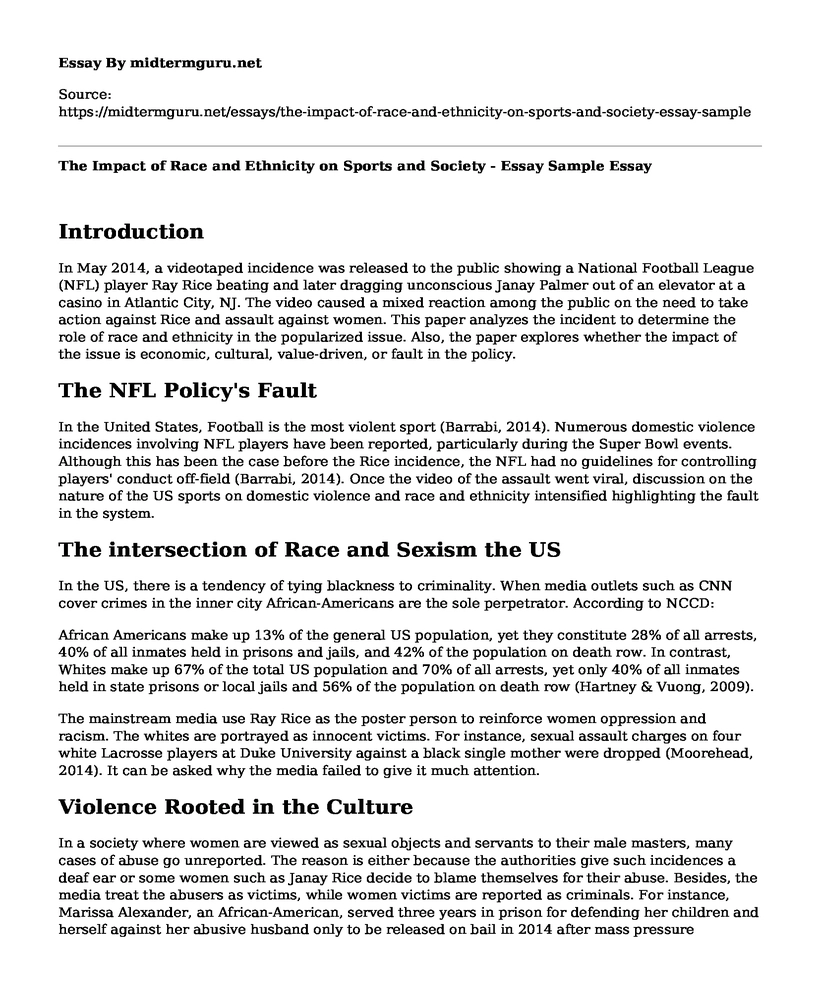Introduction
In May 2014, a videotaped incidence was released to the public showing a National Football League (NFL) player Ray Rice beating and later dragging unconscious Janay Palmer out of an elevator at a casino in Atlantic City, NJ. The video caused a mixed reaction among the public on the need to take action against Rice and assault against women. This paper analyzes the incident to determine the role of race and ethnicity in the popularized issue. Also, the paper explores whether the impact of the issue is economic, cultural, value-driven, or fault in the policy.
The NFL Policy's Fault
In the United States, Football is the most violent sport (Barrabi, 2014). Numerous domestic violence incidences involving NFL players have been reported, particularly during the Super Bowl events. Although this has been the case before the Rice incidence, the NFL had no guidelines for controlling players' conduct off-field (Barrabi, 2014). Once the video of the assault went viral, discussion on the nature of the US sports on domestic violence and race and ethnicity intensified highlighting the fault in the system.
The intersection of Race and Sexism the US
In the US, there is a tendency of tying blackness to criminality. When media outlets such as CNN cover crimes in the inner city African-Americans are the sole perpetrator. According to NCCD:
African Americans make up 13% of the general US population, yet they constitute 28% of all arrests, 40% of all inmates held in prisons and jails, and 42% of the population on death row. In contrast, Whites make up 67% of the total US population and 70% of all arrests, yet only 40% of all inmates held in state prisons or local jails and 56% of the population on death row (Hartney & Vuong, 2009).
The mainstream media use Ray Rice as the poster person to reinforce women oppression and racism. The whites are portrayed as innocent victims. For instance, sexual assault charges on four white Lacrosse players at Duke University against a black single mother were dropped (Moorehead, 2014). It can be asked why the media failed to give it much attention.
Violence Rooted in the Culture
In a society where women are viewed as sexual objects and servants to their male masters, many cases of abuse go unreported. The reason is either because the authorities give such incidences a deaf ear or some women such as Janay Rice decide to blame themselves for their abuse. Besides, the media treat the abusers as victims, while women victims are reported as criminals. For instance, Marissa Alexander, an African-American, served three years in prison for defending her children and herself against her abusive husband only to be released on bail in 2014 after mass pressure (Moorehead, 2014).
Economic Reasons (Profits Before Humanity)
The Rice and Janay incident highlights emphasis given to profits before the needs and dignity of humanity by the capitalist culture, media outlets, NFL hierarchy, and the pervasive views of society that promote women oppression. NFL like any other non-profit organization sponsoring events and giving donations receive funds from selling tickets and do not want to ruin their image by annoying their fans.
Policy Changes
Following the Ray and Janay incident, the NFL took actions by introducing suspensions and hiring outside experts (all white women) to oversee the domestic violence in the league (Belson, 2014). Although the objective was to monitor the NFL programs and policies concerning abuse, the credibility of these initiatives has been questioned on racial and ethnic grounds (Luther, 2014).
References
Barrabi, T. (2014, September 22). NFL's History of Domestic Violence Extends Beyond Ray Rice, Adrian Peterson Abuse Cases. Retrieved from: http://www.ibtimes.com/nfls-history-domestic-violence-extends-beyond-ray-riceadrian-peterson-abuse-cases-1692014.
Belson, K., (2014). NFL Domestic Violence Policy Toughened in the wake of the Ray Rice Case. Retrieved from: https://www.nytimes.com/2014/08/29/sports/football/roger-goodell-admits-he-was-wrong-and-alters-nfl-policy-on-domestic-violence.html?_
Hartney, C., & Vuong, L. (2009, March). Created Equal Racial and Ethnic Disparities in the US Criminal Justice System. Retrieved from: http://www.nccdglobal.org/sites/default/files/publication_pdf/created-equal.pdf
Luther, J., (2014, September 25). The NFL's domestic violence problem and our race problem. Retrieved from: https://www.vice.com/en_us/article/3d9e55/the-nfls-domestic-violence-problem-and-our-race-problem
Moorehead, M., (2014, September 16). Ray Rice, racism and women's oppression. Retrieved from: https://www.workers.org/2014/09/16/ray-rice-racism-womens-oppression/
Sweeney, K., Schramm-Possinger, M., Gregg, E. A., & Stranahan, H. (2016). Predicting consumer commitment: A case study of the NFL and Ray Rice. Case Studies in Sport Management,5(1), 80-85. doi:10.1123/cssm.2015-0048
Cite this page
The Impact of Race and Ethnicity on Sports and Society - Essay Sample. (2023, Jan 15). Retrieved from https://midtermguru.com/essays/the-impact-of-race-and-ethnicity-on-sports-and-society-essay-sample
If you are the original author of this essay and no longer wish to have it published on the midtermguru.com website, please click below to request its removal:
- Article Analysis Essay on the Globalization of Football: A Study in the Glocalization of the 'Serious Life'
- Essay Sample on Race and Inclusion in Academic Fields/Majors
- The Great Disparity: How Middle Class Perfect Was Manufactured - Essay Sample
- Kuba Kingdom: A 16th-Century Migratory Expansion - Research Paper
- Deborah Tannen: How Language Affects Relationships - Essay Sample
- Family Therapy: Improving Communication & Resolving Conflict - Essay Sample
- Maori in NZ: Struggling With Structural Barriers to Health Access - Essay Sample







